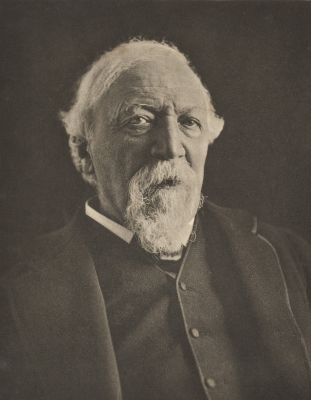
Title
Rt. Hon. W E GladstoneArtist
Myers, Eveleen (British, 1856-1937)Publication
Sun Artists Number 7Date
1891Process
PhotogravureAtelier
Walter L. Colls, LondonImage Size
16.5 x 13.6 cm
Eveleen Myers was born in London in 1856. Her mother, who had spent the first 24 years of her life in France, was an intimate of Flaubert, Gambetta and other influential French intellectuals. Her father’s salon in London was frequented by many of the leading members of London society, including William Gladstone, Sir John Ruskin, Alfred, Lord Tennyson and the painters George F. Watts and Edward Burne-Jones. Contemporary reports suggest that Eveleen Myers took up photography in 1888 with a view to taking portraits of her children. Myers may also have been influenced by her childhood experience of being photographed by Julia Margaret Cameron during a visit to the Isle of Wight. Her photographic work seems to have been largely accomplished in the period 1888 to the mid 1890’s. Myers rapidly established a considerable reputation as a portrait photographer. In 1889 she produced a series of portraits of Robert Browning with images of Gladstone, Chamberlain, Balfour and Galton the following year such is the excellence of her work that invaluable contributions to art are to be expected from the mastery she has attained. The major holding of Myers’ work is in the National Portrait Gallery, London.
Sun Artists was the first publication in England to represent ‘the artistic position of photography’. Published in eight parts between October 1889 and July 1891, each issue was devoted to the work of a single British photographer and illustrated by four hand-pulled photogravures. Particular care was taken by the publisher of Sun Artists to identify the individuals who prepared the photogravures for publication, all leading exponents of photogravure at the time. Mr Dawson of the Typographic Etching Company, himself an acclaimed photographer, made the etchings for Issue 1. Mr Cameron Swan of Messrs Annan and Swan made those for Issues 2, 3, and 4 while the etchings for Issues 5-8 were made by Mr W.L. Colls. [1]
These exceptional issues highlight those men and women who best express the period’s rich Pictorialist dialogue between painting and photography, the rise of the Secession Movement, and a turning point "in the ways photographs were made for the pages of books" [2] – namely in the photogravure process of "printing photographs from an etched copper plate" -as seen in these 32 superb hand-pulled gravures.
The photographers included are: J. Gale (essay by (George Davison); H.P. Robinson (essay by Andrew Pringle); J.B.B. Wellington (essay by Graham Balfour); Lydell Sawyer (essay by Rev. F.C. Lambert); Julia M. Cameron (essay by P.H. Emerson); B. Gay Wilkinson (essay by Rev. F.C. Lambert); F.W.H. Myers (essay by John Addington Symonds); and Frank Sutcliffe (essay by Charles N. Armfield). Sun Artists was issued in two states, a regular edition and an edition of 100 numbered copies on India proof paper, with the photogravures signed in pencil by the artists, with the exception of Julia Margaret Cameron who had already died.
References
[1] Hannavy John. 2008. Encyclopedia of Nineteenth-Century Photography. New York NY: Routledge.
[2] Goldschmidt Lucien Weston J Naef and Grolier Club. 1980. The Truthful Lens : A Survey of the Photographically Illustrated Book 1844-1914. 1st ed. New York: Grolier Club no 41
McCaully – History of Photography "Writing Photography’s History before Newhall " v 21 n 2 1997
Harker, Margaret. The Linked Ring: the Secession Movement in Photography in Britain, 1892-1910. London: Heinemann, 1979. Print.
Gernsheim, Helmut. The History of Photography: The Age of Collodion. London: Thames and Hudson, 1989. p.44
Weaver, Mike. British Photography in the Nineteenth Century: The Fine Art Tradition. Cambridge [United States: University Press, 1989. p. 157-8


